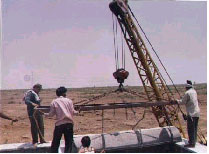|
Power of Collaboration
One of the
important functions of programme officers in the Swiss Agency of
Development and Cooperation (SDC), Switzerland, India has been to build
and maintain relationships between SDC and its partners. In Development
Alternatives (DA), many programme officers have played this interface
role.
Building this interface has been governed by SDC’s successive country
programmes in India anchored in poverty reduction, and DA’s vision of
creating sustainable livelihood options in large numbers. However, the
colleagues involved from DA and SDC and the projects they designed and
implemented gave actual shape and the character to this interface. The
relationship began with a small project and rested on the trust that
normally exists in a friendship, in this case between Dr Urs Heierli (SDC
coordinator) and Dr Ashok Khosla (Chairman, DA). Dr Arun Kumar, George
Varughese from DA and Kurt Voegele and François Binder from SDC have led
this process over the years with great openness and the necessary
flexibility.

Right from developing the micro-concrete roofing (MCR) technology to
presenting a proposal to the Government of India on the rural habitat
policy, it has been a long journey in many collaborative forms across
numerous projects and organisations in which SDC was an active partner
with DA. In the MCR project, DA was a member of an international network
project supported by SDC through SKAT, a Swiss NGO rooted in development
and promotion of appropriate technology. As SDC developed its action
lines for energy projects, the MCR project led by Shrashtant Patara
evolved into a building materials project to create affordable and
energy efficient building materials. More partners were added and DA’s
competence became the backbone of several initiatives, including TARA’s
technology marketing strategy. As SDC’s country programme became more
focused, the result was direct actions that contributed to poverty
reduction. SDC formulated a rural housing project with a number of
partners in many states of India. SDC was then looking for a partner to
host a learning platform on issues of rural housing. The basin-South
Asia regional knowledge platform was a forthcoming and a natural choice
as SDC was one of the sponsors of this international network. Zeenat and
Mona from DA championed and implemented the rural habitat policy
formulation process with inputs from 3000 individuals and agencies. This
is an example of DA’s ability to innovate on any process and product and
implement it with rigour. I am sure that my SDC colleagues Werner
Hunziker, Laurence Von Schulthess, and Subhash Jalora will draw a lot of
professional satisfaction from being a part of this programme.
Finding partners who will carry the mantle of bringing about a change on
the ground has always been a challenge in SDC. Without a partner like DA
and colleagues like Geeta Vaidyanathan, Mr Lakhmikantan, Jean-Bernard
Dubois and Soumen Maity, SDC would not have been able to bring VSBK
technology to India. The process of technology transfer and further
development involved a large number of experts from different
backgrounds, professionally and culturally, who would stay in Datia
frequently and over extended durations. Hosting such teams was feasible
only through hard work, with a lot of patience and being on the foot all
the time - another aspect of DA’s personality that SDC learnt to value
over time. DA built the VSBK service centre with partial support from
SDC.
The changing focus of SDC’s India programme posed new challenges by
making demands on the team to enter into areas such as fighting
discrimination, for which there was no previous record. This also
required each organisation to reflect on its basic orientation and hold
its own views. DA continued on its path of entrepreneur focus and
developed the first project under the carbon development community fund.
SDC DA has championed the VSBK technology in India as suitable under
today’s carbon constrained world and has also helped in spreading it in
many areas. This behaviour has been at the core of building this
interface - being ready to support each other even if there were
differences. DA, by going beyond the initial support of SDC, has
demonstrated its commitment to sustainable development. SDC, on its
part, feels satisfied at initiating a change process in a sector which
has seen very few external interventions.
The development of institutional partnership anchored in enabling the
partner institution to pursue its vision and mission was a new exercise
for both organisations. This concept was new to both SDC and DA.
Hansreudi Peiffer and Rina Tagore nurtured this idea with the DA team.
Right from the beginning, the quality of dialogue was frank and open. It
also was characterised by a multilevel and multi dimensional dialogue.
The SDC team participated in DA’s internal review meetings, and DA
participated in SDC’s planning and reflection meetings. This ability to
test and to experiment with ‘donor ideas’ without being threatened by
each other has been a hallmark of the DA-SDC partnership.
Today, DA continues to be SDC’s key dialogue partner. SDC looks forward
to implementing a path-breaking project in Bundelkhand – DA’s
Karmabhoomi – in which knowledge, dialogue and capacity building
measures amongst farmers, women’s groups and artisans will lead to
community based strategies for adaptation to climate change and enhanced
eco-security.
Lastly, we remember the discussions on the risks regarding continuity in
leadership of the organisation. SDC went ahead and took that risk and
one can say that it was a risk well taken from seeing where DA stands
today on the occasion of its Silver Jubilee - ready to take off into the
next orbit, i.e., the challenge of creating sustainable livelihoods in
large numbers.
q
Veena Joshi
and Avni Malhotra
veena.joshi@sdc.net
avni.malhotra@sdc.net
Back to Contents |